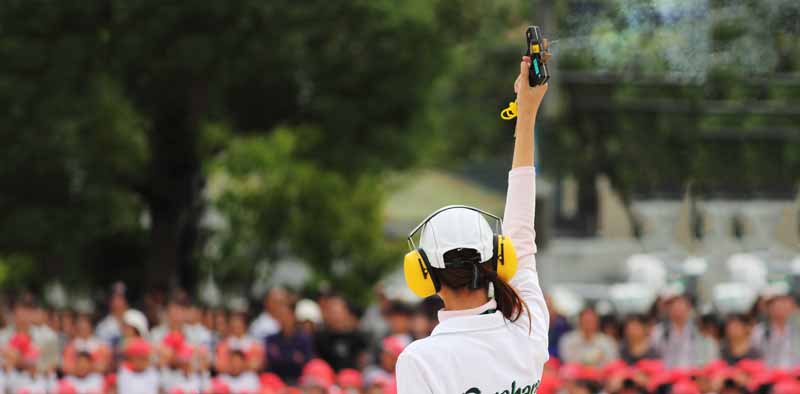
In the world of track and field, reaction time is known to be a pivotal aspect of a top-level athlete’s technical arsenal, separating the gifted from the elite. Reaction time is defined as the interval of time between the onset of a stimulus, and the initiation of a response (Magill & Anderson, 2014). Neuromuscular and psychomotor connections are the fundamental basis of the body’s reaction pathway to the brain. Gender, age, mental state, and learning experience also play a role in the athlete’s ability to react to a given stimulus (Iulian, 2012). The slower the stimulus recognition information is passed to the brain, the slower the reaction movement. In professional track and field sprint events, a delay of even one-hundredth of a second can cost the athlete a podium position.
Reaction time is followed by movement time, which in the case of a sprinter, is from the initiation of rear foot motion from the starting block to the moment the same foot touches ground; therefore, total response time is a cumulative measure of both reaction and movement time from initial stimulus to initial footstrike (Majumdar & Robergs, 2011). There is much debate in the field over whether reaction time or movement time is more crucial for sprint performances. Some experts believe that reaction time is a more inherently genetic factor, thus less trainable and of minimal importance.
Brain electrophysiological studies have confirmed that cerebral potential amplitude increases during the acquisition of a new skill, specifically premotor potential, which is the “decision-to-act” portion of reaction time; this potential was predictably higher in the expert sprinters (Collet, 1999). This revelation in neuroscience provides proof that reaction time does have an environmental basis, in other words, it is both learned and trainable.
Each limb of the body is controlled by its counterpart hemisphere in the opposite side of the brain. The left hemisphere of the brain specializes in muscle force execution while the right side for spatial and attention processing (Majumdar & Robergs, 2011). One study found that a left rear-foot start in the blocks gave a 26ms advantage in reaction time, while a right rear-foot start gave a 104ms advantage, for an overall response time advantage of 80ms (Eikenberry et al., 2008). In a 100m sprint, 80ms can be the difference between first and second place on the elite level, favoring the theory that movement time is the more important motor skill. For the purposes of this article, the focus will remain on reaction time rather than movement time and the benefits of training muscle reactivity for peak performance.
When comparing novice sprinters to their adult counterparts, reaction time shortens markedly in the trained, experienced runners (Collet, 1999). World-class sprinters’ reaction times typically fall around 145ms, making for incredibly quick explosion from the blocks (Collet, 1999). The International Amateur Athletics Federation (IAAF) enforces the 100ms-false start rule based on the notion that below this threshold, the athlete must have anticipated the shot and initiated early; the reaction times at major world competitions are scrutinized with live motion capture cameras on the starting line for this reason (Collet, 1999).
Reaction time out of the starting blocks is not the only instance where swift reactivity would be beneficial. Every footstrike produces ground reactive forces, and the goal of the athlete is to quickly touchdown and immediately take off with the return of energy from the ground. The greatest determinant of speed has been documented as the runner’s ability to generate greater ground reactive forces and shorten his or her ground-contact time. This requires exemplary reactivity, every step of the way.
A study from the Journal of Sports Sciences, investigated lower-limb joint kinetics and stiffness in relation to performance time and velocity (Charalambous, Irwin, Bezodis, & Kerwin, 2012). Musculoskeletal stiffness effectively loads the body for optimal utilization of elastic energy and increases the ground reactive forces and velocities as the athlete seemingly explodes off the ground. Specifically, the ankle joint stores elastic energy in the plantar flexor muscles, which absorb impact and prevent limb collapse, and releases the energy as power at push-off (Charalambous et al., 2012). Joint and tendon stiffness is trained with a variety of methods, some of which include plyometrics, depth jumps, and one- or two-legged jumping circuits. The emphasis should be on full-footed contacts, stiff landings, and explosive initiations.
From a coaching perspective, there are a few key take-home points for building a stronger, more reactive speed athlete. First, emphasize the right rear-foot stance for boosting movement time advantage. Second, incorporate resistance training at high velocities for explosive neuromuscular development, such as with dynamic, power-based plyometrics. Third and last, train for joint and tendon stiffness with directional jumping drills, and a drop in reaction time will soon follow. Taking these components of neuromuscular development and efficiency into play will yield the greatest adaptations in muscular and kinematic control over the athlete’s reaction to a given race stimulus, and performance will be enhanced as a result.
Please share this article so others may benefit.
[mashshare]References
Charalambous, L., Irwin, G, Bezodis, I. N., & Kerwin, D. (2012). Lower limb joint kinetics and ankle joint stiffness in the sprint start push-off. Journal of Sport Sciences, 30(1), 1-9.
Collet, C. (1999). Strategic aspects of reaction time in world-class sprinters. Perceptual and Motor Skills, 88(1), 65-75.
Eikenberry, A., McAuliffe, J., Welsh, T. N., Zerpa, C., McPherson, M., Newhouse, I. (2008). Starting with the “right” foot minimizes sprint start time. Acta Psychologica, 127(2), 495-500.
Iulian, A. D. (2012). Study regarding the relation between the accumulation of psycho-motor experience in the practice of sprint events, and the value of start reaction time. Scientific Journal of Education, Sports, and Health, 13(2), 62-69.
Magill, R., & Anderson, D. (2014). Motor learning and control: Concepts and applications (10th ed.). New York, NY: McGraw-Hill.
Majumdar, A. S. & Robergs, R. A. (2011). The science of speed: Determinants of performance in the 100m sprint. International Journal of Sports Science and Coaching, 6(3), 479-493.


